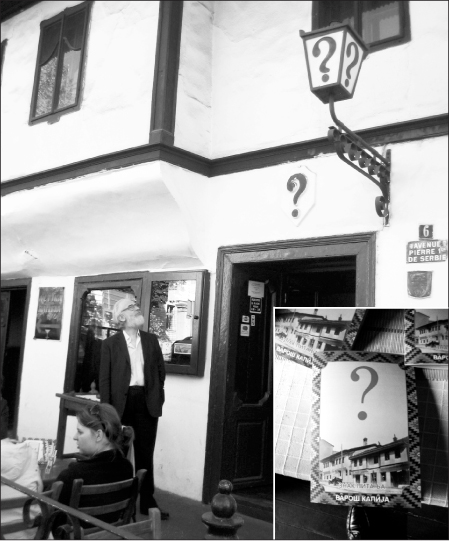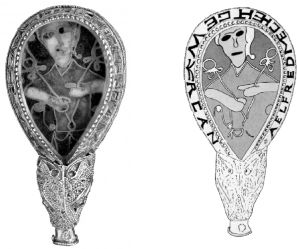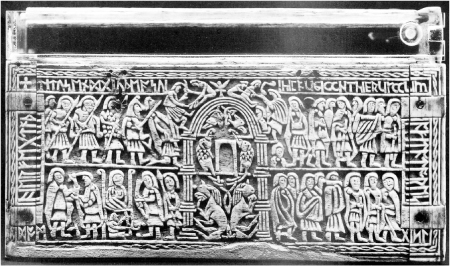Making a Point
Authors: David Crystal


Making a point
DAVID CRYSTAL
is Honorary Professor of Linguistics at the University of Wales, Bangor. His many books range from clinical linguistics to the liturgy and Shakespeare. He is the author of
The Story of English in 100 Words
and
Spell It Out: The Singular History of English Spelling
, both published by Profile. His
Stories of English
is a Penguin Classic.
Also by David Crystal
The Cambridge encyclopedia of language
The Cambridge encyclopedia of the English language
The stories of English
The fight for English
Think on my words: an introduction to Shakespeare's language
Txting: the gr8 db8
By hook or by crook: a journey in search of English
A little book of language
Evolving English: one language, many voices
Begat: the King James Bible and the English language
Internet linguistics
Just a phrase I'm going through: my life in language
The story of English in 100 words
Wordsmiths and warriors: the English-language tourist's guide to Britain (with Hilary Crystal)
Spell it out: the singular story of English spelling
The disappearing dictionary
Words in time and place
The Oxford illustrated Shakespeare dictionary (with Ben Crystal)
Making a point:
the pernickety story of English punctuation
David Crystal

First published in Great Britain in 2015 by
PROFILE BOOKS LTD
3 Holford Yard
Bevin Way
London
WC1X 9HD
Copyright © David Crystal, 2015
The moral right of the author has been asserted.
All rights reserved. Without limiting the rights under copyright reserved above, no part of this publication may be reproduced, stored or introduced into a retrieval system, or transmitted, in any form or by any means (electronic, mechanical, photocopying, recording or otherwise), without the prior written permission of both the copyright owner and the publisher of this book.
A CIP catalogue record for this book is available from the
British Library.
eISBN 978 1 78283 108 2
Contents
 Â
3
To point, or not to point?
Interlude: Punctuation says it all
 Â
7
Breath, blood, and spirits
Interlude: A punctuation heavyweight
Interlude: The Good Child's Book of Stops
11
The way forward: meanings and effects
Interlude: Punctuation minimalism
12
Interfering with Jane Austen
Interlude: Another case: Emily Dickinson
13
Is there a punctuation system?
Interlude: Learning about layout
Interlude: Inverting exclamation
29
Apostrophes: the present (and future)
30
Marks of inclusion (or exclusion): round brackets
Interlude: The poet of parentheses
31
Marks of inclusion: âquotation marks'
Interlude: A fashionable vulgarism
Interlude: Punctuation eccentricity
Envoi: Gertrude Stein on punctuation
Appendix: Teaching punctuation
A preliminary dialogue
There are two extreme views about punctuation.
the first is that you dont actually need it because its perfectly possible to write down what you want to say without any punctuation marks or capital letters and people can still read it youdontevenneedspacesbetweenwordsreally they dont exist when we speak to each other after all and yet we nonetheless or should it be none the less understand what people are saying
The second is that it's essential because it aids legibility. It's much easier to read if there's punctuation. Also, the marks show us how to read aloud in a way that reflects the pauses, rhythm, and melody that we use in speech. They help us see the grammar of complex sentences. And they help us sort out ambiguities â otherwise nobody would ever have got the joke in
Eats
(,)
Shoots & Leaves
.
but that joke was funny precisely because its so unusual we dont encounter that sort of ambiguity most of the time when we write and its crazy to have to learn a complicated system that nobody agrees about just so that we can sort out rare cases of ambiguity
But punctuation isn't only about ambiguity and intelligibility. It also shows our identity as educated people. For historical reasons, society expects people to spell correctly and to punctuate correctly.
how can anything be correct if theres so much disagreement
about it theres an example already in what youve written you put a comma in after the word rhythm in your first comment thats something a lot of people including some ministers of education would disapprove of
There are historical reasons for that, too.
what are these historical reasons you keep going on about
Read on â¦
A traveller's introduction
If you walk along the main shopping street in Belgrade, in the direction of Kalemegdan Park, and turn left just before you reach the end, you will find yourself in Kralja Petra street. Towards the bottom, opposite the Serbian Orthodox cathedral, is the oldest traditional
kafana
, or tavern, in the city. And its name is a punctuation mark.
A question mark, to be precise. And that is how everyone knows it. People say they will meet âat the question-mark tavern' â
znak pitanja
in Serbian. You can't miss it, as on the outside wall is a prominent lantern with a large question mark on it. And inside you are surrounded by menu question marks. It is a typographical paradise. If there were a Question-Mark Protection Society, this is a place where its members would surely wish to end their days.
Behind every punctuation mark lies a thousand stories, and nowhere is a story more interesting than in the case of number 6 Kralja Petra. In 1892, the owner wanted a new name for his tavern and looked for the nearest landmark, which was the church across the street. So he called it âBy the Saborna Church'. But he hadn't taken into account the likely reaction of the Church authorities, who were furious at the thought of the name of their cathedral being associated with a pub. Temporarily at a loss for an alternative, he put a question mark on the door. And it stayed.
A question mark as the name of a pub. It's a function of
punctuation that would never have been dreamed of by those who first thought of adding marks to their writing to make it easier to read. But the story of English punctuation is littered with such personal preferences, unusual practices, and arbitrary decisions â as well as occasional linguistic reasoning. For such a tiny system â only a dozen or so marks in common use, after all â there's an amazing amount of uncertainty over usage.

The author admires the question-mark tavern. (inset) The tavern menu cover
.
And an even more amazing amount of personal involvement. What other area of language has generated motivation of the kind shown by the two enthusiasts who went hunting for punctuational errors all the way across America, correction-pens in hand, risking jail in the process? What other area of language has produced as specific an organization as the Apostrophe Protection Society? What other account of a language topic has achieved anywhere near the remarkable 3-million-plus sales of Lynne Truss's punctuation manifesto,
Eats, Shoots & Leaves
?
When a language is written down for the first time, the writer has to perform two apparently simple tasks: spell the words, and punctuate the sentences. Both turn out to be unexpectedly complicated. I've told the story of how writers solved the spelling task in
Spell It Out
. This book tells the story of how they solved the second â or rather, didn't entirely solve it, judging by the furious rows over what counts as correct punctuation which still surface in the media. One only has to write
potato's
to elicit an emotional reaction of biblical proportions.
There is something really special about punctuation, and its story needs to be told. Who were the people who introduced punctuation to the English language? Why did they do it? How did their invention evolve over the centuries? When did the enthusiasms and uncertainties originate? What is happening to punctuation today? And what is its future? That is what this book is about.
1
In the beginning â¦
Up on the second floor in the Ashmolean Museum in Oxford, in a gallery displaying artefacts from early England, there is a beautiful teardrop-shaped object. A decorated golden frame surrounds a colourful enamelled design protected by a flat panel of polished rock crystal. It shows the picture of a man dressed in a green tunic, and holding a flowered sceptre in each hand, his wide eyes gazing intently at something we do not see. And around the rim of the object, just a few millimetres thick, is an Old English inscription in Roman letters:
AELFREDMECHEHTGEWYRCAN
There are no spaces between the words. Inserting these, we get
AELFRED MEC HEHT GEWYRCAN
Alfred       me  ordered       to make
= Alfred ordered me to be made
This is King Alfred the Great, and the object has come to be called the Alfred Jewel.
It was found near Athelney Abbey in Somerset in 1693, the place where Alfred launched his successful counter-attack against the Danes in 878. There has been much debate about the identity of the man, and what the purpose of the jewel was. An important clue is the base of the object, which is in
the form of a dragon-like head with a cylindrical socket in its mouth. What did that socket hold? Probably a pointer, used to help a reader to follow the lines of text in a manuscript, which would often be placed on a stand some distance away from the reader. It's now thought the large-eyed figure represents the sense of sight. His eyes are wide open and focused because he is reading.

The Alfred Jewel in outline, showing (left) the location of the inscription on the object, and (right) the way the inscription surrounds the figure
.
For people interested in English punctuation, the jewel inscription provides an important opening insight. There isn't any. This is a sentence, but there's no full stop. All the letters are the same, capitals, so there's no contrast showing where the sentence begins or that Alfred is a name. And the inscription lacks what to modern eyes is the most basic ortho-graphic device to aid reading: spaces to separate the words.
Sixty miles away, in another museum, there's another remarkable object from Anglo-Saxon times: the Franks Casket. This is an intricately carved whalebone box that was presented to the British Museum by one of its curators, Augustus Franks, in 1867. Each side of the box displays
scenes from Roman, Jewish, Christian, and Germanic traditions, accompanied by an explanatory inscription in English and Latin. The English words are written in runes, and if I transcribe a few in their Roman letter equivalents, they would look like this:
HERFEGTAP+TITUSENDGIUPEASU
Once again, there are no word-spaces. Inserting them, we get
HER FEGTAÃ +TITUS END GIUÃEASU
Here      fight     Titus   and     Jews
It is a description of the capture of Jerusalem by Emperor Titus in AD 70. (The letter à represents a âth' sound.)
This state of affairs is common in the inscriptions of the period. Many have no spacing or punctuation marks at all. Today, word-spaces are such an obvious and universal feature of the written language that we can easily forget they are there, and ignore their role as a device of punctuation. But a word-space is just as much a punctuation feature as is its close relative, the hyphen. And one of the topics I'll discuss later in this book will be the uncertain trading-relationship between spaces and hyphens. Should a word be written spaced, hyphenated, or solid? Is it
flower pot
,
flower-pot
, or
flowerpot
?
Word-spaces are the norm today; but it wasn't always so. It's not difficult to see why. We don't actually need them to understand language. We don't use them when we speak, and fluent readers don't put pauses between words as they read aloud. Read this paragraph out loud, and you'll probably pause at the commas and full stops, but you won't pause between the words. They run together. So, if we think of writing purely as a way of putting speech down on paper,
there's no reason to think of separating the words by spaces. And that seems to be how early writers thought, for unspaced text (often called, in Latin,
scriptura continua
) came to be a major feature of early Western writing, in both Greek and Latin. From the first century AD we find most texts throughout the Roman Empire without words being separated at all. It was thus only natural for missionaries to introduce unspaced writing when they arrived in England.

The back of the Franks Casket, showing the Titus inscription. The sequence of runes begins at the bottom left-hand corner and continues across the top up to the mid-point
.
Writing in antiquity was viewed by most people as a guide to reading aloud. Today, we tend to read silently, privately, rapidly. We can skim through text if we wish, omitting portions. In early Greek and Roman civilization, people routinely read aloud to audiences in displays of oratory, every syllable was valued, and eloquence was highly rated. No skimming then. A text would have been well prepared before being read in public, so that it became more like a musical
score, reminding the reader what to say next. In such circumstances, experienced readers wouldn't need word-spaces or other marks. Some influential writers, indeed, poured scorn on punctuation. Cicero, for example, thought that the rhythm of a well-written sentence was enough to tell someone how to bring it to an effective close. Punctuation marks were unnecessary.
But without punctuation of any kind, readers would have to do their homework to avoid unexpected miscues. We would have to do our homework too, if we had no word-spacing today. Faced with the sentence
therapistsneedspecialtreatment
we need to know if this is a text about sex crimes or about speech pathology before we can correctly read it aloud. Early writers on oratory and rhetoric, such as Aristotle and Quintilian, often illustrated the dangers of misreading an unpunctuated text, and stressed the need for good preparation. Familiarity, they hoped, would breed content.
We can carry out an experiment to show how familiarity with a text helps our reading of it, even if it is unspaced. Take a text you know well, and write it down without word-spaces, then try reading it aloud. Like this:
tobeornottobethatisthequestion
ourfatherwhoartinheavenhallowedbethyname
jackandjillwentupthehilltofetchapailofwater
Our knowledge of the content enables us to read it quickly. But with a bit more effort we can do this even if we don't know the text in advance. In fact, this is something we're increasingly doing these days, as a result of the Internet.
Domain names don't use word-spaces. Consider the following addresses:
It may take us a millisecond or two longer to read these strings, but we can do it.
Scriptura continua
is back!
In Anglo-Saxon times in England, inscriptions typically don't show any sign of punctuation. But not all. What is thought to be the very earliest sentence inscribed in English in fact does show word division. This is the Undley bracteate, a tiny gold medallion found at Undley in Suffolk in 1982, and dated to the second half of the fifth century AD. It consists of three words in runic letters, and the words are separated by small circles:
gægogæ º mæga º medu
The meaning is uncertain â one version translates the Old English as âthis she-wolf is a reward to my kinsman' â but the way the runemaster worked is clear enough. This man wanted his words separated. Punctuation practices evidently varied from the very beginning.
Interlude: Silent reading

In antiquity, to encounter someone reading silently was sufficiently unusual that it could elicit a comment. In Book 6 (
Chapter 3
) of his
Confessions
, St Augustine recalls how as a young man he wanted to ask questions of his mentor, St Ambrose, Bishop of Milan, but felt unable to do so when he visited him because of the way Ambrose was reading:
When he read, his eyes scanned the page and his heart explored the meaning, but his voice was silent and his tongue was still ⦠when we came to see him, we found him reading like this in silence, for he never read aloud. We would sit there quietly, for no one had the heart to disturb him â¦
Augustine puzzles over why Ambrose was doing this â not even using the muffled voice that someone would typically use when alone:
Perhaps he was afraid that, if he read aloud, some obscure passage in the author he was reading might raise a question in the mind of an attentive listener, and he would have to explain the meaning or even discuss some of the more difficult points. If he spent time in this way, he would not manage to read as much as he wished. Perhaps a more likely reason why he read to himself was that he needed to spare his voice, which quite easily became hoarse. But whatever his reason, we may be sure it was a good one.
Translation by R S Pine-Coffin from
Saint Augustine: Confessions(Penguin Classics, 1961).
